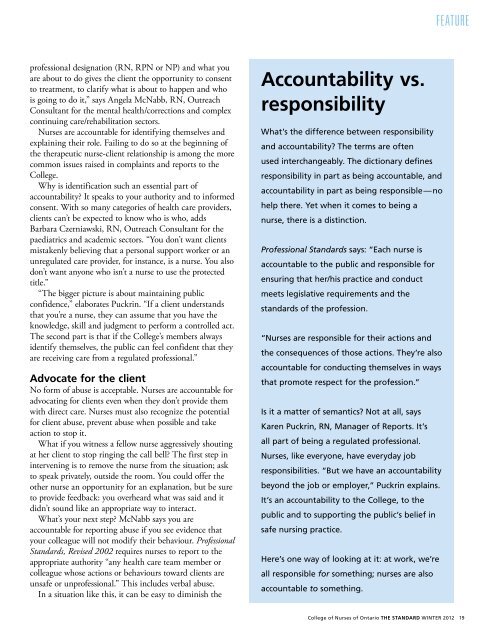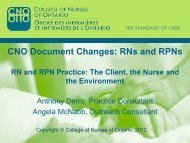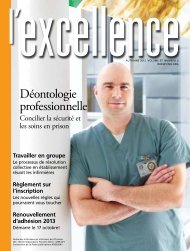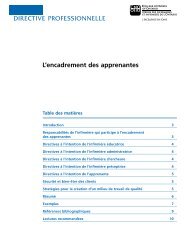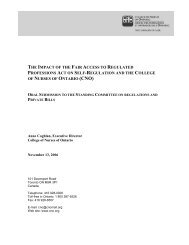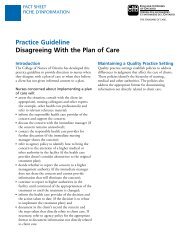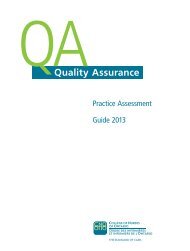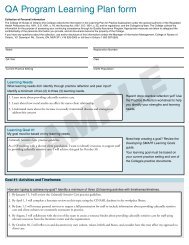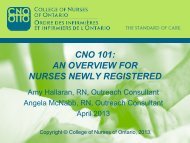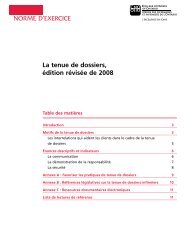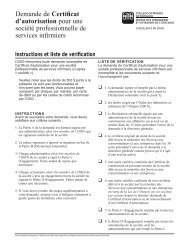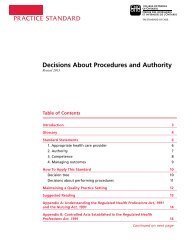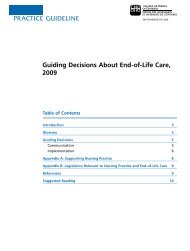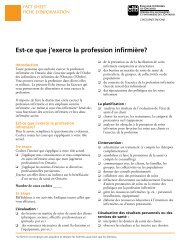The Standard, Winter 2012 - College of Nurses of Ontario
The Standard, Winter 2012 - College of Nurses of Ontario
The Standard, Winter 2012 - College of Nurses of Ontario
You also want an ePaper? Increase the reach of your titles
YUMPU automatically turns print PDFs into web optimized ePapers that Google loves.
Featurepr<strong>of</strong>essional designation (RN, RPN or NP) and what youare about to do gives the client the opportunity to consentto treatment, to clarify what is about to happen and whois going to do it,” says Angela McNabb, RN, OutreachConsultant for the mental health/corrections and complexcontinuing care/rehabilitation sectors.<strong>Nurses</strong> are accountable for identifying themselves andexplaining their role. Failing to do so at the beginning <strong>of</strong>the therapeutic nurse-client relationship is among the morecommon issues raised in complaints and reports to the<strong>College</strong>.Why is identification such an essential part <strong>of</strong>accountability? It speaks to your authority and to informedconsent. With so many categories <strong>of</strong> health care providers,clients can’t be expected to know who is who, addsBarbara Czerniawski, RN, Outreach Consultant for thepaediatrics and academic sectors. “You don’t want clientsmistakenly believing that a personal support worker or anunregulated care provider, for instance, is a nurse. You alsodon’t want anyone who isn’t a nurse to use the protectedtitle.”“<strong>The</strong> bigger picture is about maintaining publicconfidence,” elaborates Puckrin. “If a client understandsthat you’re a nurse, they can assume that you have theknowledge, skill and judgment to perform a controlled act.<strong>The</strong> second part is that if the <strong>College</strong>’s members alwaysidentify themselves, the public can feel confident that theyare receiving care from a regulated pr<strong>of</strong>essional.”Advocate for the clientNo form <strong>of</strong> abuse is acceptable. <strong>Nurses</strong> are accountable foradvocating for clients even when they don’t provide themwith direct care. <strong>Nurses</strong> must also recognize the potentialfor client abuse, prevent abuse when possible and takeaction to stop it.What if you witness a fellow nurse aggressively shoutingat her client to stop ringing the call bell? <strong>The</strong> first step inintervening is to remove the nurse from the situation; askto speak privately, outside the room. You could <strong>of</strong>fer theother nurse an opportunity for an explanation, but be sureto provide feedback: you overheard what was said and itdidn’t sound like an appropriate way to interact.What’s your next step? McNabb says you areaccountable for reporting abuse if you see evidence thatyour colleague will not modify their behaviour. Pr<strong>of</strong>essional<strong>Standard</strong>s, Revised 2002 requires nurses to report to theappropriate authority “any health care team member orcolleague whose actions or behaviours toward clients areunsafe or unpr<strong>of</strong>essional.” This includes verbal abuse.In a situation like this, it can be easy to diminish theAccountability vs.responsibilityWhat’s the difference between responsibilityand accountability? <strong>The</strong> terms are <strong>of</strong>tenused interchangeably. <strong>The</strong> dictionary definesresponsibility in part as being accountable, andaccountability in part as being responsible — nohelp there. Yet when it comes to being anurse, there is a distinction.Pr<strong>of</strong>essional <strong>Standard</strong>s says: “Each nurse isaccountable to the public and responsible forensuring that her/his practice and conductmeets legislative requirements and thestandards <strong>of</strong> the pr<strong>of</strong>ession.“<strong>Nurses</strong> are responsible for their actions andthe consequences <strong>of</strong> those actions. <strong>The</strong>y’re alsoaccountable for conducting themselves in waysthat promote respect for the pr<strong>of</strong>ession.”Is it a matter <strong>of</strong> semantics? Not at all, saysKaren Puckrin, RN, Manager <strong>of</strong> Reports. It’sall part <strong>of</strong> being a regulated pr<strong>of</strong>essional.<strong>Nurses</strong>, like everyone, have everyday jobresponsibilities. “But we have an accountabilitybeyond the job or employer,” Puckrin explains.It’s an accountability to the <strong>College</strong>, to thepublic and to supporting the public’s belief insafe nursing practice.Here’s one way <strong>of</strong> looking at it: at work, we’reall responsible for something; nurses are alsoaccountable to something.<strong>College</strong> <strong>of</strong> <strong>Nurses</strong> <strong>of</strong> <strong>Ontario</strong> the standard winter <strong>2012</strong>19


